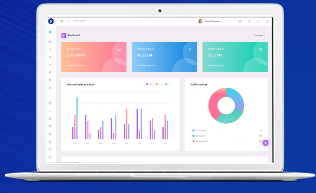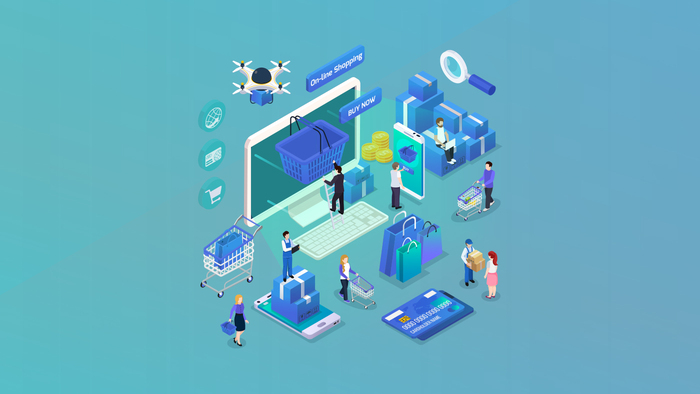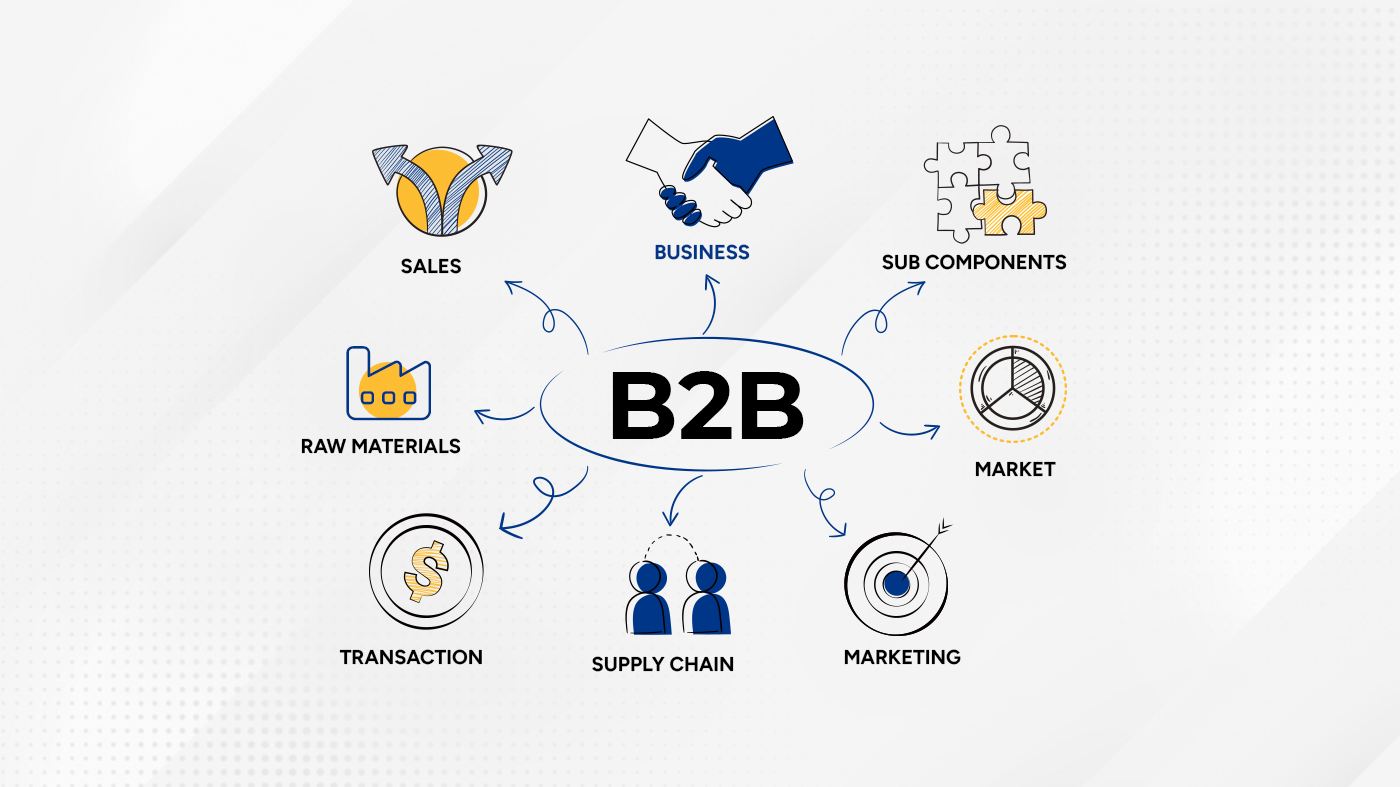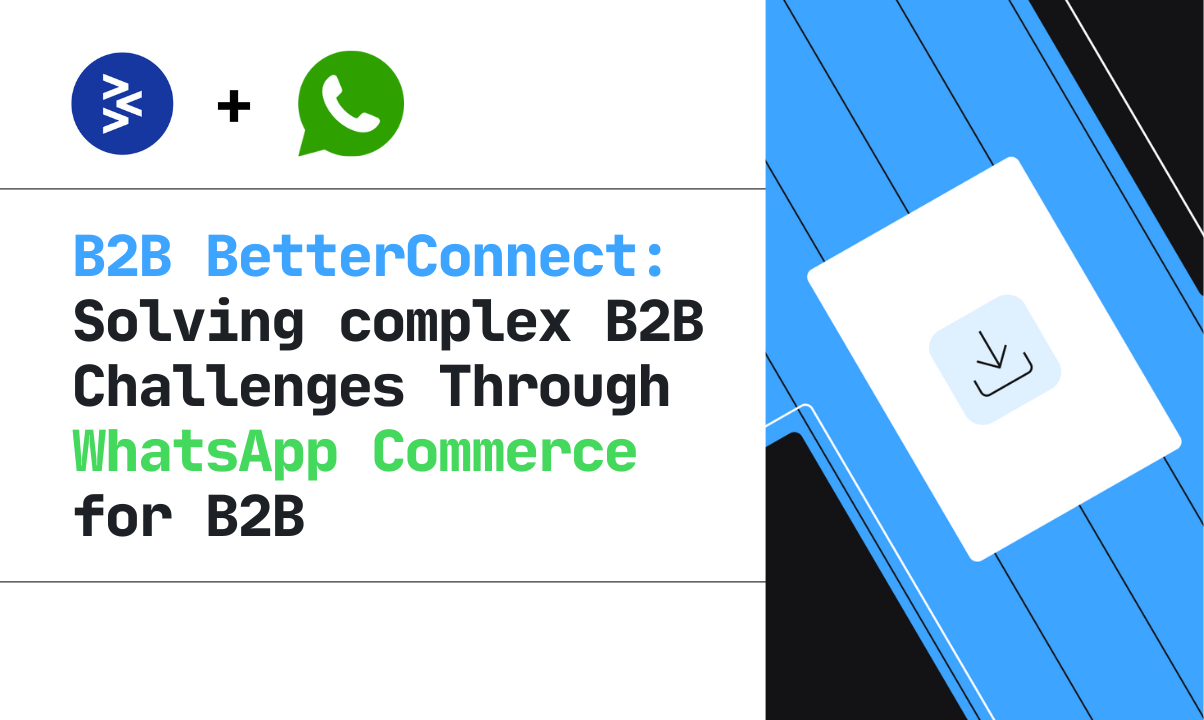Ready to drive in?
Schedule a demo
In the current commerce market, customers are hungry about the product information when making buying decisions. Thus, it becomes important to provide a better and accurate product information to your customers.

Tags
b2b buyer
b2b commerce
b2b strategies
B2B modern technology
B2b
Quickstart Guide
Tips and Strategies

30-October-2024

41 min read
Table Of Contents
Section 1: Introduction
- Overview of the modern B2B landscape
Section 2: Understanding B2B commerce
- Key drivers of change
Section 3. Past vs. present B2B buyer behaviour
- Traditional sales-driven approaches
- Shift to self-directed research
- The role of digital channels
- Statistical insights
Section 4. Key characteristics of the modern B2B buyer
- Research-oriented
- Demand for speed and convenience
- Personalisation and customisation
- Value of transparency and trust
Section 5. Navigating the non-linear B2B buying journey
- Complex decision-making process
- Non-linear pathways
Section 6. The role of content marketing in meeting buyer needs
- High-value, relevant content
- SEO and searchability
- Mobile optimisation and page speed
- Content distribution and promotion
- Measuring SEO success
Section 7. Personalisation and customisation for modern B2B buyers
- Utilising data and analytics
- CRM data
- Social media analytics
- Feedback loops
- Account-based marketing (ABM) for targeted B2B engagement
- Personalised engagement
- Tailoring content at each touchpoint
- Customised landing pages
Section 8. Reducing friction in the B2B buying process
- Identifying key friction points
- Solutions for a frictionless experience
- Making friction reduction a continuous priority
Section 9. Building trust and credibility with modern B2B buyers
- Establishing thought leadership
- Leveraging social proof
Section 10. Lessons from B2C for B2B experiences
- B2C influences on B2B
- Adopting omnichannel strategies
Section 11. Future trends in B2B buyer expectations
- AI and machine learning for enhanced buyer insights
- Sustainability as a buyer priority
- Growing impact of social commerce
Section 12. Conclusion: The future of the B2B buyer
Section 1: Introduction
Overview of the modern B2B landscape
The landscape of business-to-business (B2B) transactions is undergoing a significant transformation. The rapid advancement of digital technologies has dramatically changed how organisations conduct business and how buyers approach purchasing decisions. Traditional methods are being replaced by digital-first strategies, necessitating a deeper understanding of buyer behaviour and expectations. This shift emphasises the importance of businesses adapting to meet these evolving demands.
As B2B buyers increasingly prefer self-directed research and digital interactions, understanding and adapting to their expectations has become a cornerstone of competitive advantage. Companies that effectively respond to these changes can build stronger relationships with their customers, enhance loyalty, and ultimately drive growth.
This article aims to guide businesses on how to navigate the new landscape shaped by modern B2B buyer expectations. It explores the evolution of the B2B buyer, key characteristics of the modern buyer, and actionable strategies to adapt to these new dynamics. By focusing on these elements, organisations can position themselves for success in a rapidly changing marketplace.
Section 2: Key drivers of change
The landscape of B2B purchasing is evolving rapidly, influenced by several key drivers that have fundamentally changed buyer behaviour. Understanding these drivers is crucial for businesses looking to adapt to the modern B2B environment.
1. Proliferation of technology
The technological revolution has drastically altered how B2B buyers interact with suppliers and make purchasing decisions. With the rise of the internet, cloud computing, and mobile devices, buyers now have unprecedented access to information at their fingertips. They can research products, compare prices, and read reviews without ever needing to engage directly with sales representatives.
According to a study by Gartner, nearly 77% of B2B buyers find it helpful to have access to online resources that inform their purchasing decisions. This shift has empowered buyers to take charge of their purchasing journeys, making them more informed and confident. The availability of advanced tools like Artificial Intelligence (AI) and Machine Learning (ML) also allows buyers to analyse data trends, helping them make informed decisions faster than ever.
2. Increased access to information
The sheer volume of information available online has transformed the B2B buyer’s journey. Buyers are no longer limited to the information provided by sales teams or marketing materials; they can explore third-party reviews, case studies, and industry reports to gather insights.
According to research by DemandGen, 61% of B2B buyers prefer to engage with content from third parties. This reliance on external sources not only influences their perceptions of brands but also shapes their purchasing decisions. Therefore, businesses must invest in creating high-quality, informative content that resonates with their target audience and helps them in their research process.
3. Rise of millennials and Generation Z
As Millennials and Gen Z enter the workforce and take on decision-making roles, their unique expectations are reshaping B2B purchasing dynamics. These younger generations have grown up in a digital world and naturally gravitate toward personalised and user-friendly experiences.
Research by LinkedIn indicates that 83% of Millennials in B2B decision-making roles believe that their personal preferences heavily influence their professional purchasing decisions. They prioritise vendors who understand their needs and can provide tailored solutions. Consequently, businesses that fail to adapt to these generational expectations risk losing valuable market share.
4. Globalisation and remote work
The increasing interconnectedness of markets has also played a significant role in changing B2B buyer behaviour. As businesses operate globally, buyers now have access to a wider range of suppliers and solutions. This expanded marketplace raises expectations for quality, price, and service. Additionally, the COVID-19 pandemic has accelerated the trend toward remote work, which has further influenced how buyers interact with suppliers.
With teams working from different locations, the ability to collaborate seamlessly online has become essential. Buyers expect digital solutions that facilitate smooth communication, easy access to information, and efficient transaction processes.
Section 3. Past vs. present B2B buyer behaviour
The evolution of B2B buyer behaviour from traditional to modern approaches reflects the broader changes in the marketplace. Understanding this transition is vital for organisations seeking to engage effectively with their customers.
1. Traditional sales-driven approaches
In the past, B2B sales relied heavily on personal relationships and direct interactions. Sales representatives would often be the primary source of information for buyers, guiding them through the purchasing process. The emphasis was on face-to-face meetings, phone calls, and personal connections.
This model required extensive relationship-building and relied on the sales team's expertise to persuade buyers. However, this approach was limited by geographical constraints and the availability of sales personnel. As a result, the sales cycle could be long and cumbersome, often leading to frustration on both sides.
2. Shift to self-directed research
The modern B2B buyer has moved away from this sales-centric model toward a self-directed approach. Buyers now prefer to gather information independently, utilising digital channels to conduct their research before engaging with sales teams.
A study by McKinsey found that 70% of B2B buyers conduct their research online before making a decision, highlighting a fundamental shift in how buyers interact with suppliers. This change has transformed the sales cycle; buyers expect suppliers to be readily available to answer questions or provide support when they are ready to engage.
3. The role of digital channels
Digital channels have become the primary means through which buyers gather information. They engage with content through websites, social media, webinars, and email campaigns. According to the Content Marketing Institute, 74% of B2B buyers consume three or more pieces of content before making a purchasing decision.
This reliance on digital content underscores the need for businesses to provide high-quality, informative, and easily accessible resources that address buyer questions and concerns throughout their research process.
4. Statistical insights
Recent statistics further underscore this transformation in B2B buyer behaviour. Research by leadIQ indicates that 68% of B2B buyers prefer to research online independently rather than engage directly with a sales representative. This preference emphasises the importance of digital presence and online resources in influencing purchasing decisions.
Moreover, the rise of reviews and peer recommendations plays a crucial role in the modern buyer's journey. A study by BrightLocal found that 84% of people trust online reviews as much as a personal recommendation. This trend underscores the importance of building a positive online reputation and leveraging social proof to build trust with potential buyers.
Section 4. Key characteristics of the modern B2B buyer
Research-oriented
Modern B2B buyers are increasingly research-oriented, with a strong emphasis on self-education. This trend is driven by the vast amount of information available online and the ease of access to resources. Today's buyers are equipped with tools that allow them to conduct thorough research before engaging with sales representatives.
- Value of comprehensive content
Buyers expect businesses to provide high-quality, informative content that addresses their pain points and answers their questions. This includes case studies, white papers, industry reports, and FAQs that offer valuable insights and actionable advice. A survey by Demand Gen reported that 67% of B2B buyers rely more on content to inform their decisions than on sales representatives. Consequently, organisations must invest in creating diverse content types that cater to various buyer preferences and learning styles.
- Importance of transparency
Research-oriented buyers also seek transparency in the information they consume. They appreciate brands that present data clearly and honestly, allowing them to make informed decisions. Providing easily accessible information, such as pricing details, product specifications, and customer testimonials, helps build credibility and trust.
- Demand for speed and convenience
In an era where instant gratification is the norm, B2B buyers increasingly expect speed and convenience in their purchasing journeys. This expectation mirrors the experiences they encounter in B2C transactions, where quick responses and seamless interactions are the standard.
- Streamlined processes
Organisations must streamline their processes to accommodate these expectations. This includes optimising website navigation, improving load times, and ensuring that buyers can easily find the information they need without unnecessary hurdles. Quick access to resources, such as product demos and pricing calculators, can enhance the overall buyer experience.
- Rapid communication
Timely communication is also essential. B2B buyers want prompt responses to inquiries, whether through live chat, email, or phone calls. According to HubSpot, 90% of consumers expect an immediate response when they have a sales question. Fulfilling these expectations can significantly enhance customer satisfaction and improve conversion rates.
Personalisation & customisation
Today’s B2B buyers demand tailored experiences. This ranges from customised solutions to personalised digital content. Companies that can adapt their offerings and communications to meet individual buyer needs will stand out in a competitive market.
- Tailored solutions
Companies that can adapt their offerings to meet the specific requirements of individual buyers stand out in a competitive market. This could involve customising product features, pricing models, or service levels based on buyer feedback and requirements.
- Personalised content & engagement
Personalisation extends to marketing communications as well. Utilising data analytics, businesses can create targeted campaigns that resonate with specific buyer segments. For example, personalised email campaigns that reflect the recipient’s interests or previous interactions can significantly increase engagement rates. According to Epsilon, personalised emails generate six times higher transaction rates than non-personalised emails.
Value of transparency & trust
Trust is a critical factor in B2B relationships. Modern buyers seek transparency in communication, pricing, and business practices. Building trust through open and honest interactions can significantly enhance buyer relationships.
- Building trust through transparency
Businesses that prioritise transparency in their dealings—whether regarding product quality, pricing structures, or business practices—tend to build stronger relationships with their buyers. Providing clear information about products, services, and processes fosters an environment of trust, encouraging buyers to engage more freely.
- Open & honest interactions
Establishing trust involves more than just transparency; it requires a commitment to open and honest interactions. Organisations must be willing to listen to buyer concerns, address issues promptly, and provide genuine support throughout the buyer journey. According to a study by Edelman, 81% of consumers need to trust a brand before they buy from it, highlighting the significance of trust in influencing purchasing decisions.
Section 5. Navigating the non-linear B2B buying journey
Complex Decision-Making Process
The B2B buying journey is characterised by its complexity, often involving multiple stakeholders with diverse priorities and concerns. Typically, a single purchase decision may include 6 to 10 individuals, each contributing unique perspectives.
- Diverse stakeholders
Each stakeholder may have different objectives, ranging from financial considerations to operational requirements and risk assessments. Understanding the roles and motivations of these individuals is critical for businesses aiming to engage effectively.
- Consensus-building
This complexity necessitates a collaborative approach, where consensus among stakeholders is essential before finalising a purchase. Businesses must develop strategies to communicate effectively with each stakeholder group, addressing their specific needs and concerns throughout the decision-making process.
Non-linear pathways
The B2B buying journey is no longer linear. Buyers move fluidly through various stages, necessitating flexible and stage-specific content to engage them effectively. This requires a deep understanding of buyer personas and their respective needs at each stage of the journey. Modern B2B buyers navigate a non-linear path, moving fluidly between different stages of the purchasing process.
- Fluid buyer journeys
Buyers may revisit earlier stages of the journey, conduct additional research, or consult with different stakeholders at various points. This non-linear behaviour requires businesses to develop flexible, stage-specific content that aligns with the buyer's current needs.
- Understanding buyer personas
A deep understanding of buyer personas and their respective needs at each stage of the journey is crucial. Organisations must analyse the buyer’s motivations, challenges, and preferred content formats to create relevant and impactful resources that guide them through the decision-making process.
In summary, the non-linear B2B buying journey requires businesses to adopt a comprehensive strategy that acknowledges the complexities of multiple stakeholders and the fluid nature of buyer interactions. By prioritising consensus-building and creating targeted content for diverse buyer personas, organisations can enhance engagement and support buyers effectively throughout their decision-making journey.
Section 6. The role of content marketing in meeting buyer needs
High-value, relevant content
To meet the demands of modern buyers, organisations must create high-value, relevant content that addresses buyer pain points. Preferred content formats include case studies, whitepapers, and videos that provide insights and solutions.
- Understanding buyer pain points
Organisations must conduct thorough research to understand their target audience's needs, concerns, and common challenges. By identifying these pain points, businesses can tailor their content to offer meaningful insights and actionable solutions. This approach not only demonstrates empathy but also positions the brand as an authority in the industry.
- Preferred content formats
Different buyers have varying preferences when it comes to content formats. Some of the most effective types of content for B2B audiences include:
1. Case studies: These provide real-world examples of how products or services have successfully solved specific challenges for clients. Case studies not only highlight the effectiveness of solutions but also build credibility and trust.
2. Whitepapers: Comprehensive and informative, whitepapers delve deep into specific topics, offering in-depth analysis and research. They are particularly useful for complex issues, making them valuable for decision-makers seeking thorough understanding.
3. Videos: As visual content continues to dominate, videos can effectively convey complex information quickly and engagingly. They can be used for product demonstrations, explainer videos, or even customer testimonials, making them a versatile tool in a content strategy.
By consistently providing high-value content that resonates with their audience, businesses can nurture relationships over time. When buyers find informative and helpful resources, they are more likely to return to that brand for future needs, fostering loyalty and encouraging repeat business.
SEO & searchability
In addition to creating valuable content, organisations must focus on optimising their digital content for search engines to increase visibility and attract inbound leads. Effective SEO strategies play a critical role in ensuring that potential buyers can easily find relevant information.
- Importance of keyword research
Identifying and utilising the right keywords is essential for driving organic traffic. Businesses should conduct comprehensive keyword research to understand the terms and phrases their target audience uses when searching for information related to their products or services. This includes long-tail keywords that reflect buyer intent.
- On-page optimisation
Optimising content for search engines involves several on-page factors, including:
o Meta tags and descriptions: Crafting compelling meta titles and descriptions can improve click-through rates from search engine results pages (SERPs).
o Headings and subheadings: Using appropriate headings and subheadings enhances readability and helps search engines understand the content structure.
o Internal and external links: Incorporating links to relevant internal and external resources can improve content authority and provide additional value to readers.
- Mobile optimisation & page speed
As more users access content via mobile devices, ensuring that digital content is mobile-friendly is crucial. Additionally, optimising page load speeds can enhance user experience and contribute to better search rankings. According to Google, pages that load within 3 seconds have lower bounce rates and higher engagement levels.
- Content distribution and promotion
Simply creating high-quality content is not enough; organisations must also invest in promoting it effectively. This includes leveraging social media channels, email marketing, and online communities to share content and drive traffic. By actively engaging with their audience and distributing content through various channels, businesses can maximise their reach and impact.
- Measuring SEO success
Tracking key performance indicators (KPIs) related to SEO efforts is essential for understanding the effectiveness of strategies. Metrics such as organic traffic, keyword rankings, and conversion rates provide insights into what is working and where improvements are needed. Tools like Google Analytics and Ahrefs can help businesses monitor and analyse these metrics effectively.
Section 7. Personalisation and customisation for modern B2B buyers
Utilising data and analytics
Data and analytics are essential in creating individualised buyer journeys. In today's data-driven landscape, leveraging data and analytics is essential for crafting individualised buyer journeys. By utilising Customer Relationship Management (CRM) data, organisations can gain deep insights into customer behaviour, preferences, and engagement patterns. This information allows businesses to refine their marketing strategies and tailor their offerings to align with buyer expectations.
CRM data
Customer Relationship Management (CRM) systems are a goldmine of insights for understanding buyer behaviour and preferences. By analysing historical interactions, businesses can identify trends across various customer segments, determine which products or services resonate best, and even predict future purchasing patterns. For example:
• Trends and patterns: If a specific segment of customers frequently interacts with content around topics like sustainability or digital transformation, the CRM can reveal these patterns. Businesses can then develop messaging that aligns with these interests, strengthening their relevance.
• Customer segmentation: CRM data helps with effective segmentation, enabling personalised campaigns targeted at groups that exhibit similar behaviours, needs, or goals. This is particularly valuable when creating tailored email content or targeted marketing campaigns.
• Predictive insights: CRMs with machine learning capabilities can go a step further, providing predictive insights that help anticipate buyer needs, such as interest in new product launches, seasonal preferences, or trends in repeat purchases.
Social media analytics
Social media platforms offer real-time insights into customer sentiment, preferences, and engagement patterns. By leveraging social media analytics, businesses can:
• Monitor brand sentiment: Track how buyers feel about their brand or industry, noting any recurring themes. Positive or negative sentiment trends can guide marketing campaigns to either reinforce successful aspects or address concerns.
• Engagement metrics: Platforms provide data on which types of content buyers engage with most. For example, if videos about a particular product feature have high engagement rates, businesses can create additional video content to address similar topics or questions.
• Content relevance: Social analytics can reveal interests across different customer segments, allowing organisations to craft content that directly addresses these areas. Real-time feedback enables companies to pivot content strategy promptly, ensuring it remains relevant and valuable.
By using social media analytics, companies can stay closely aligned with evolving customer needs, allowing them to deliver more engaging, timely content.
Feedback loops
Creating mechanisms for direct buyer feedback is crucial in refining products and enhancing customer experience. Common feedback tools include surveys, interviews, and Net Promoter Scores (NPS). Here’s how feedback loops add value:
• Direct insights: Customer surveys or interviews provide firsthand insights into what buyers like or dislike about a product, service, or experience. This information is invaluable for making data-backed improvements.
• Continuous improvement: Feedback loops enable companies to iterate on products or services based on real buyer input. For example, if feedback indicates friction in the onboarding process, adjustments can be made to streamline it, boosting buyer satisfaction.
• Actionable NPS scores: Net Promoter Scores can indicate overall customer satisfaction and loyalty, giving a clear picture of buyer experience quality. By identifying areas where NPS is low, companies can prioritise improvements that address customer concerns.
Feedback loops allow businesses to stay in tune with buyer expectations, ensuring their offerings remain relevant and optimised for satisfaction.
Account-based marketing (ABM) for targeted B2B engagement
Account-Based Marketing (ABM) is essential in B2B marketing, allowing organisations to engage high-value accounts with precision. By focusing on specific accounts and customising outreach to individual stakeholders, companies can foster deeper relationships and address the unique needs of each group. ABM’s core elements include:
Targeting specific accounts
ABM begins by identifying accounts that align with an organisation’s goals and represent significant business opportunities. This targeted approach allows businesses to focus resources on high-potential accounts.
• Account prioritisation: By conducting account segmentation, companies can determine which accounts to prioritise, factoring in criteria such as revenue potential, industry fit, or the likelihood of conversion.
• Resource allocation: ABM enables businesses to allocate resources, like specialised teams or dedicated marketing budgets, to target these accounts effectively, increasing the chances of success.
This approach ensures marketing resources are used efficiently, focusing on accounts that offer the greatest return on investment.
Tailoring marketing efforts
ABM goes beyond merely identifying target accounts; it customises marketing efforts for each account and stakeholder. This strategy allows companies to address specific pain points and needs, fostering stronger engagement.
• Customised messaging: Different stakeholders within an account often have varying priorities. For instance, a CFO may be focused on cost savings, while an IT director may prioritise technical features. Tailoring messaging to address each stakeholder’s specific needs ensures that content is relevant and engaging.
• Targeted content: ABM campaigns often involve personalised content, such as case studies, whitepapers, or webinars designed for specific accounts. For example, a case study might highlight how the product helped a similar organisation in the industry, appealing directly to the target account's unique needs.
By aligning messaging with stakeholder interests, companies can build trust and increase the likelihood of conversion.
Personalised engagement
ABM supports building strong, personalised relationships with key accounts by enabling a deeper level of engagement through direct outreach and customised content.
• Direct outreach: Personalised emails, calls, and meetings allow for direct interaction with key decision-makers within each account. This level of engagement fosters trust and positions the business as a true partner.
• Tailored offers: Offering custom solutions or discounts to targeted accounts can also be an effective ABM strategy, as it shows a commitment to meeting their unique needs.
By fostering personalised engagement, ABM not only improves conversion rates but also enhances customer retention and loyalty.
Tailoring content at each touchpoint
A seamless, personalised experience across all touchpoints is essential for guiding buyers effectively through their journey. Here’s how companies can leverage dynamic content, PIM, and CMS to tailor interactions:
Dynamic content
With tools that enable dynamic content, businesses can present personalised messages and product recommendations based on a buyer’s past behaviour and current stage in the journey.
• Product-specific content: Using Product Information Management (PIM) systems, businesses can display accurate and customised product information based on the buyer’s interests. For instance, if a buyer has shown interest in eco-friendly products, dynamic content can emphasise sustainability features of related products.
• Real-time adaptations: Dynamic content generation allows companies to adjust messaging in real-time, providing product or service suggestions that align with recent buyer interactions, making the experience highly relevant.
Dynamic content increases engagement by giving buyers a tailored experience that aligns with their specific needs and preferences.
Personalised emails
Email remains a powerful tool for personalised engagement, especially when combined with segmentation strategies.
• Segmentation-driven campaigns: By using data from CRM and social analytics, companies can segment email lists based on behaviour, ensuring recipients receive content that aligns with their interests.
• Follow-up customisation: Following events like webinars or downloads, targeted follow-up emails can offer additional resources, insights, or product recommendations based on the participant’s engagement.
Personalised emails enhance engagement and build stronger relationships with prospects by delivering relevant, timely information.
Customised landing pages
Tailored landing pages aligned with buyer journeys provide an optimised experience that improves conversion.
• PIM and CMS integration: By integrating PIM with a Content Management System (CMS), companies can dynamically adjust landing page content, showcasing product details and resources aligned with buyer interests.
• Relevant testimonials and case studies: Customised landing pages can feature industry-specific case studies or testimonials that speak directly to the buyer’s sector and needs, enhancing credibility.
Customised landing pages help guide buyers by presenting them with the right information at the right time, increasing the likelihood of conversion.
Section 8. Reducing friction in the B2B buying process
Reducing friction in the B2B buying process is critical to meeting the demands of today’s fast-paced, information-driven buyers. B2B buyers expect efficiency, transparency, and convenience throughout their journey, and eliminating friction is key to delivering this experience. Below, we’ll explore common friction points, their impact, and practical solutions for creating a smoother, more satisfying buying process.
In B2B transactions, lengthy timelines, complex product details, and multiple stakeholders can often introduce obstacles in the buying journey. Identifying and addressing these friction points is crucial to delivering a seamless buyer experience.
Identifying key friction points
1. Complex pricing structures
o Challenge: B2B pricing is often complex, with variations based on volume, customisation, and negotiated terms. When buyers encounter opaque or overly complicated pricing structures, it can create confusion and delay decision-making.
o Impact: Complex pricing can lead to a loss of trust, frustration, and ultimately, decision fatigue. If buyers cannot easily assess costs or understand pricing terms, they may look elsewhere for solutions that are more transparent.
o Insight: According to Gartner, 77% of B2B buyers reported that their latest purchase was complex or difficult. Simplifying and clearly explaining pricing can reduce barriers and improve buyer confidence in decision-making.
2. Slow response times
o Challenge: In an era of real-time communication, delayed responses from sales or customer support teams can be a major source of friction. Buyers want quick, accurate responses to their inquiries—whether it’s about product details, pricing, or post-sale support.
o Impact: Slow response times can derail momentum, particularly in the research and decision stages. For example, Forrester Research found that 90% of B2B buyers begin their buying process with a need for informational content but are often discouraged by delayed responses.
o Insight: Reducing response times is key to keeping buyers engaged, especially as B2B buyers often prefer self-directed research, meaning they’re ready for answers as soon as they initiate contact.
3. Insufficient information accessibility
o Challenge: When B2B buyers can’t access the information they need—whether it’s detailed product specifications, customer testimonials, or clear return policies—the buying process can become cumbersome.
o Impact: Lack of accessible information creates gaps in the buyer’s research journey and can prompt them to abandon the process or choose a competitor with clearer, more readily available information.
o Insight: ResearchGate study shows that 60% of buyers prefer not to interact with sales reps as their primary source of information, favouring self-service options instead. Providing easy access to valuable information is therefore a powerful strategy for B2B companies.
Solutions for a frictionless experience
To meet the needs of modern buyers, organisations can implement digital solutions that streamline the buying process and reduce friction at each stage. Here are some effective approaches:
1. Automated sales rooms
o Solution: Automated sales rooms are centralised, digital environments where buyers and sellers can collaborate in real-time. These virtual rooms allow sales teams to share documents, respond to queries, and showcase product details in a single, organised space.
o Benefits: Automated sales rooms enable streamlined communication and make it easier for buyers to access needed resources, track progress, and engage with sales teams. This approach reduces back-and-forth emails and offers a more cohesive experience.
2. Comprehensive FAQ databases
o Solution: A well-organised FAQ database can address common buyer questions, offering quick and accessible answers. This solution helps answer product, policy, or implementation questions without requiring live assistance, making it ideal for the self-directed buyer.
o Benefits: An FAQ database saves time for both buyers and sales teams. By offering immediate answers to common questions, companies reduce dependency on customer support and allow prospects to continue their research without delay.
3. Responsive customer support channels
o Solution: Modern customer support goes beyond traditional phone lines, encompassing live chat, chatbots, and social media channels that allow customers to connect instantly with a representative or get automated answers.
o Benefits: By offering 24/7 support through live chat or AI-driven chatbots, businesses can provide timely assistance, resolve issues in real-time, and even route complex queries to human agents when necessary.
o Example: AI-powered chatbots enable instant support for common questions, reducing wait times significantly. For instance, chatbots can offer personalised product recommendations, provide order status updates, and answer frequently asked questions instantly.
4. Clear and transparent pricing calculators
o Solution: Pricing calculators allow buyers to customise configurations and receive instant price estimates, which can be especially helpful in B2B environments with complex or variable pricing models.
o Benefits: Providing an online pricing calculator gives buyers clarity, builds trust, and supports faster decision-making. Buyers feel empowered with the information they need to make cost comparisons without needing direct input from a sales rep.
5. Self-service content libraries
o Solution: B2B buyers often conduct extensive research before contacting a sales rep. Self-service content libraries offer access to case studies, product demos, whitepapers, and testimonials—resources that allow buyers to engage with information on their terms.
o Benefits: By creating a content library accessible to buyers at any stage of the buying process, companies reduce information gaps. Self-service content enables buyers to answer many of their own questions, moving them closer to a purchase decision independently.
o Example: Companies like IBM and BetterCommerce offer robust content libraries that include product specifications, industry reports, and ROI calculators, allowing prospects to explore resources that address their unique needs and concerns.
Making friction reduction a continuous priority
Identifying and eliminating friction points in the B2B buying process is not a one-time task; it requires ongoing attention. Regularly gathering feedback from buyers, monitoring engagement metrics, and leveraging analytics to pinpoint areas of friction are essential practices. Here are some strategies to sustain this effort:
1. Customer feedback loops: Regularly gathering feedback from prospects and customers provides direct insights into potential friction points. Post-purchase surveys, interviews, and follow-ups can help identify specific stages where buyers encountered delays or frustrations.
2. A/B testing of touchpoints: By testing various elements like response time, pricing clarity, or content accessibility, businesses can identify which changes positively impact buyer experience. A/B testing enables companies to optimise touchpoints and gradually reduce friction across the entire journey.
3. Analytics-driven optimisation: Leveraging analytics tools can provide insights into drop-off points and engagement metrics, indicating where friction is likely occurring. For example, if buyers frequently abandon the pricing page, this could indicate that the pricing structure needs simplification.
4. Continuous training for sales teams: Training sales and support teams to recognise and address common friction points can improve buyer interactions. Providing these teams with tools to deliver clear, consistent messaging and quick responses keeps the buying process smooth.
In today’s digital-first B2B landscape, buyers prioritise seamless, efficient experiences. Reducing friction points—from complex pricing and slow response times to information gaps—is essential for creating a positive buying journey. By implementing digital solutions like automated sales rooms, FAQ databases, and responsive support, businesses can enhance the buyer experience, building trust and increasing conversions in the process.
Section 9. Building trust and credibility with modern B2B buyers
As the B2B landscape grows more competitive, establishing trust and credibility becomes essential to winning and retaining customers. Modern B2B buyers are well-informed and often cautious, requiring businesses to show consistent value, reliability, and authenticity. Here’s how organisations can effectively build credibility:
Establishing thought leadership
Organisations can establish authority in their field by consistently sharing insightful content and demonstrating expertise. Thought leadership helps build credibility and trust with buyers.
• Consistent content sharing: Thought leadership is about consistently delivering value through insightful content—such as whitepapers, industry reports, and expert blog posts—that addresses the pressing concerns of the industry. For instance, organisations that regularly publish on emerging trends, regulatory changes, or industry pain points are more likely to be viewed as experts.
• Educational webinars and workshops: Hosting webinars and workshops allows businesses to engage directly with their audience, answer questions in real-time, and showcase expertise. These interactive platforms allow buyers to experience an organisation's knowledge firsthand, establishing authority.
• Research and original studies: Publishing original research or surveys adds a level of credibility that can distinguish a company as a trusted resource. Original data and studies can provide unique insights and establish authority, as buyers often reference this research in their decision-making.
Leveraging social proof
Using testimonials, peer reviews, and case studies can strengthen buyer confidence. Social proof is a powerful tool in B2B marketing, as buyers often look to others for validation of their choices.
• Customer testimonials and case studies: Case studies and testimonials provide real-world evidence of how an organisation’s products or services have successfully met client needs. Highlighting specific results and the journey of a satisfied client helps new buyers visualise the potential outcomes for their businesses.
• Peer reviews and ratings: Sites like G2, Capterra, and TrustRadius are influential in the B2B space, as buyers often look for peer validation. Positive reviews on these platforms can help foster trust, as they provide independent confirmation of a company’s claims.
• Industry certifications and partnerships: Partnerships with well-regarded companies or certifications from reputable industry bodies can significantly boost credibility. For example, if an organisation is certified by ISO or partners with a leading tech firm, buyers are more likely to view it as a trusted provider.
Section 10. Lessons from B2C for B2B experiences
The consumer-driven strategies of B2C have reshaped expectations across the board. B2B buyers, accustomed to the seamless, personalised experiences of B2C, now expect similar treatment in their professional purchases.
B2C influences on B2B
• Speed and responsiveness: B2B buyers now expect the same rapid response times as B2C customers. Quick response times, streamlined processes, and real-time updates are increasingly valued in B2B, impacting how companies handle inquiries, support, and order processing.
• Personalisation at scale: Like B2C, B2B buyers want personalised content and recommendations. Organisations can leverage data to create tailored communications and recommendations based on past interactions, preferences, and role-specific needs.
• Seamless experiences across platforms: B2C buyers are used to smooth, unified experiences across web, mobile, and social platforms. B2B buyers now expect the same, leading companies to focus on improving user interfaces and aligning experiences across devices and channels.
Adopting omnichannel strategies
• Integrated multi-platform presence: B2B companies are embracing omnichannel strategies to reach buyers on their preferred platforms—whether through email, social media, or industry forums. This approach not only expands reach but ensures that buyers receive consistent messaging wherever they engage with the brand.
• Connected data for consistency: To offer a seamless experience, B2B companies must integrate their data sources across channels. With consolidated data from CRM, website analytics, and social media, companies can deliver consistent and relevant information at each touchpoint.
• Enhanced customer journey mapping: Mapping the customer journey across channels helps businesses understand buyer behaviour and adapt their engagement strategies. An omnichannel approach, backed by journey mapping, enables a smoother and more intuitive buyer experience.
Section 11. Future trends in B2B buyer expectations
Staying ahead of emerging trends is essential for businesses looking to meet the evolving expectations of B2B buyers.
Here are some of the transformative trends shaping the future of B2B:
AI and machine learning for enhanced buyer insights
Artificial intelligence (AI) and machine learning are playing an increasingly important role in understanding buyer behaviour. These technologies can provide predictive insights that allow organisations to tailor their approaches to individual buyers:
• Predictive analytics: AI-driven predictive analytics allows businesses to forecast buyer behaviour, enabling proactive engagement. For example, if a buyer’s behaviour indicates they are close to a purchase decision, AI can suggest specific actions to nudge them towards conversion.
• Personalised experiences: Machine learning can analyse a buyer’s interaction history and provide real-time recommendations, like suggesting content or products tailored to their unique needs. This real-time personalisation can lead to a more relevant and satisfying buyer experience.
• Optimised sales processes: AI can automate routine tasks like lead scoring and follow-ups, allowing sales teams to focus on high-priority leads. This enhances efficiency and ensures that each buyer receives timely, appropriate attention.
Sustainability as a buyer priority
The demand for transparency around sustainable practices is growing. B2B buyers are increasingly prioritising sustainability in their purchasing decisions, prompting organisations to adopt more responsible practices.
• Environmental and social responsibility: Increasingly, B2B buyers seek partnerships with companies that demonstrate sustainable practices. For example, an organisation’s commitment to reducing its carbon footprint or using ethically sourced materials can influence buying decisions.
• Transparent reporting: Buyers expect transparency regarding sustainability efforts. Detailed reporting on environmental impacts, such as carbon emissions or recycling rates, adds credibility and builds trust among conscientious buyers.
• Alignment with corporate social responsibility (CSR): Many organisations have CSR goals aligned with sustainability. B2B suppliers that can demonstrate alignment with these goals have an edge, as they support the buyer’s own CSR initiatives.
Growing impact of social commerce
Social media is becoming a vital platform for relationship building, brand presence, and the B2B buyer journey. Organisations must harness social commerce to engage with buyers effectively.
• Community engagement and networking: Social media is increasingly essential for engaging with B2B buyers, providing a platform for thought leadership, customer interaction, and brand visibility. LinkedIn, for example, allows companies to showcase expertise and connect directly with potential buyers.
• Direct social selling: While still more common in B2C, social selling in B2B is on the rise. Platforms like LinkedIn allow sales teams to engage directly with prospects through personalised outreach, building relationships in a space where buyers are already active.
• Social proof on social channels: Sharing customer testimonials, case studies, and industry accolades on social platforms reinforces credibility. B2B buyers frequently research brands on social media, so showcasing achievements there can positively influence perceptions.
Section 12. Conclusion: The Future of the B2B Buyer
The landscape of B2B buying is evolving rapidly, driven by digital transformation, rising buyer expectations, and cross-industry influences. For businesses to remain competitive, they must embrace these changes, adopting strategies that meet buyers’ heightened expectations for convenience, personalisation, and trustworthiness.
Organisations that stay agile, leverage advanced analytics, and prioritise transparent, responsible practices will not only keep pace but gain a significant competitive advantage. The modern B2B buyer’s journey requires a blend of innovation, empathy, and strategic foresight. By aligning with the needs and preferences of today’s B2B buyers, companies position themselves for long-term growth and resilience in an ever-shifting marketplace.
Other Related Articles
Download in-deph guides on key commerce topics


.jpg)
-feature.jpg)




